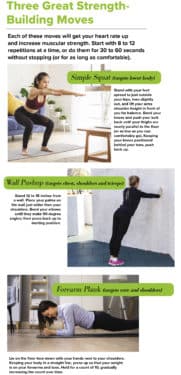Build more activity into your day
How much time do you spend sitting? Probably more than you realize. The average American adult sits for more than nine hours a day.
All that sitting means that more than 75% of us, according to the Centers for Disease Control (CDC), aren’t getting the recommended amount of exercise. Yet, the fitter you are, the longer you’re likely to live. Cardiovascular fitness has a direct effect on long-term mortality, according to a study published in the Journal of the American Medical Association. A sedentary lifestyle may be even worse for your health than smoking, heart disease, or diabetes.
But it’s never too late to start moving. Everyone can improve their health and extend their lifespan by getting, and staying, more active during the day.
Made to move
Sitting isn’t just bad for physical health — it takes a mental toll as well, and can contribute to depression, fatigue, and irritability.
“Our bodies were made to move,” says Matt Janus, an exercise physiologist and wellness coordinator at OSF Healthcare in Pontiac, Illinois. “That’s why we have muscles. Moving around gets your heart rate up and makes you feel more energized, releases endorphins, and can be a mood booster. It’s also a good coping mechanism for stress.”
Our sedentary, technology-driven lifestyles promote sitting and looking at screens to an extreme. “This kind of lifestyle puts us at higher risk of diseases like heart disease, diabetes, and chronic pain. It can also cause our muscles to atrophy a bit more and as we age, make things harder for us,” Janus says.
While dedicated exercise is important, moving more throughout the day is key. Janus draws a distinction between exercise and activity. “The problem is that folks will go and exercise for half an hour and the rest of the time they’re sedentary — and sitting the rest of the day is doing harm,” he says.
So even if you work out regularly, make a goal of staying active during the day with the following strategies:
Set a reminder.
If you have a FitBit or smart watch, program it to remind you to get up and move every hour. You can also use an alarm on your phone to prompt you.
Start slowly.
If you’ve been sedentary, aim for brief activity bursts of five to 10 minutes at a time, with a goal of reaching the CDC’s recommendation of a minimum of 150 minutes of moderate aerobic activity every week.
Mix it up.
“We recommend a good mix of aerobic exercise and strength training,” Janus says. “So one break might be going for a short walk or doing some marching in place, and the next might be doing some sit-and-stands, squats, or wall pushups.”
Think fun first.
Moving should be enjoyable. Dance around your living room. Challenge your partner or kids to a plank-holding contest. Practice yoga positions. “If it’s something you enjoy that gets your body moving, you’ll stick with it,” Janus says. “Ninety percent of the battle is getting started.”

Originally published in the Fall 2022/Winter 2023 print issue.

Kelly K. James is a longtime freelancer who covers health, fitness and wellness topics from Downers Grove, where she lives with her family.












